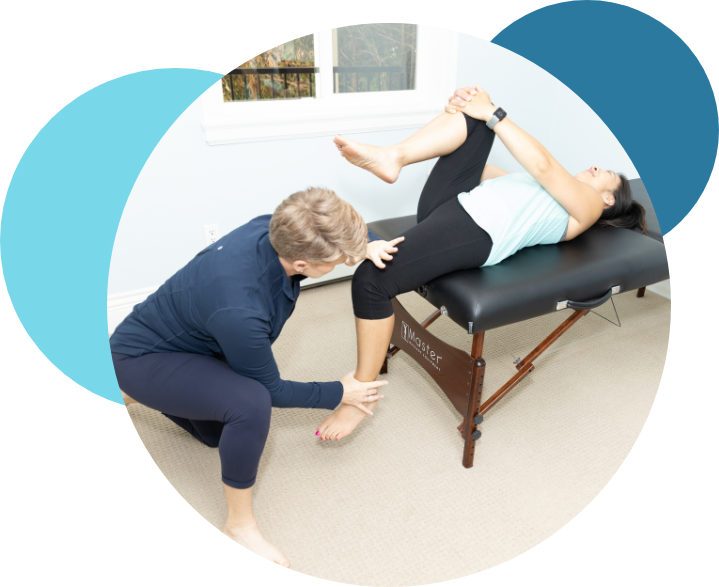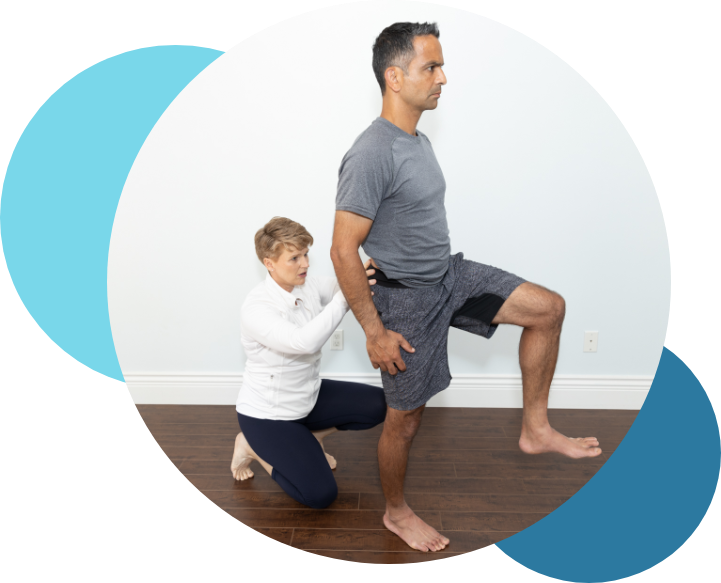
Maybe you’ve been dealing with ongoing pain ever since an injury, or you’ve gradually started to notice you can’t move how you used to, or perhaps you simply want to make sure your body is in the best possible shape. No matter what brings you in, there’s a physiotherapy treatment for you.
Because pain and injuries can be so hard to identify on your own, and because there are so many types of treatments available, it can feel overwhelming trying to decide on the best course of action. That’s why beginning your journey to a pain-free life with an in-depth physiotherapy assessment is the best way to get you feeling better.
With over two decades of experience as a physiotherapist and Pilates instructor, I’ve learned that there’s no better way to help my clients than by truly getting to know them. In my experience, the ability to understand people, their problems, and their goals tends to be equally as important as the physiotherapy skills I use in my sessions. That’s why I always take the time to sit down with each client and learn about them before beginning treatment.


Even if you’re sure you know what the problem is, and you think you know what will help you, it’s still important to take the time for a proper initial assessment. Your answers about your personal experience with this issue provide valuable information on the true cause of the problem, since these issues often go much deeper than meets the eye. It also gives me a sense of how severe the pain or problem is, and tells me what parts of your body to focus on when creating a treatment plan.
The assessment also provides you with an opportunity to learn more about your body. I’ve learned how to link pain and other symptoms back to their true origins, which are often hard to identify. This information is hugely beneficial for clients, who may be aggravating the problem without even knowing it through their daily habits. I also get the chance to share a list of exercises and treatment, so that you can put in the time to recover outside of sessions as well.

The first thing I discuss with new clients is, of course, the problem that’s brought them in to see me. Whether it’s pain and lack of flexibility from an injury, or a chronic issue with a less obvious cause, I prioritize finding out about any physical symptoms. Once I understand the problem, I learn how it’s been affecting their life. This doesn’t always seem like an obvious way to learn more about the issue or injury, but there are a number of things that can give me insight into what’s going on, such as:
Are you in more pain at home? At work? When doing other specific activities?
Are there any activities (anything from a daily jog to bending over) that you’ve been unable to do?
Have you had to change the way you do certain things because of this problem?
At home, are you looking after kids or senior parents who might need physical help from time to time?
All of these questions can help me understand potential causes for the problem, as well as give me a sense of the impact it’s been having on your regular life. This helps me develop a customized treatment plan for each client that’s tailored for their responsibilities and routines.
From here, it’s a matter of going more in-depth on the problem itself. Some of the questions I ask are:
On a scale of 1-10, how much pain/discomfort are you in?
How long have you been feeling like this?
How comfortable is it for you to sit, stand, walk, etc.?
What aggravates the pain, and what makes it feel better?
What are your recovery goals?
This tells me more about the problem at hand, as well as gives us a starting point to reference back to during treatment. For instance, I’ll ask you how much pain you’re in on a scale of 0-10 (0 is no pain and 10 is going to hospital due to the pain.) This gives me valuable information about the problem, and also gives us a clear foundation to build upon. Physiotherapy doesn’t fix people overnight, but as we keep checking in, you’ll notice that you’re rating your pain lower and lower as the weeks go on, and/or noticing it less frequently.
I also ask clients about their medical history. Have you had other problems like this in the past? Problems that might seem minor or unrelated, such as asthma, fractures, numbness, tingling, pins and needles, etc.? Have you had any surgeries? All of this helps me to form an objective understanding of the problem that brings you in, which helps me narrow down the issue and get started on an effective treatment plan as soon as possible.
After a few questions, I always do a physical assessment as well. This is also known as an objective assessment, since it helps me to see firsthand what kinds of issues you’re experiencing. I’ll take a look at your posture to see how gravity might be impacting your body. I’ll also often do a series of tests to see what muscles are being impacted by your injury or issue, so I can further hone in on the true source of the problem. I’ll also walk you through some simple exercises to check certain muscle groups for pain, weakness, or lack of flexibility, such as your core, legs, and shoulders.
Once we’ve finished with the questions and the physical assessment, I move onto education. When you work with a physiotherapist, you’re putting your trust in them to take the best possible care with your treatment, and I believe that a big part of that is ensuring my clients understand why we do what we do. After the initial assessment, I explain what I’ve found, and outline the steps we need to take to get started on your recovery. Often, there’s a muscle group or two that needs to be focused on in order to get stronger and better support the rest of your body. I’ll give a general sense of the steps we need to take, so that you understand what you’re in for prior to creating the treatment plan.
When it’s all said and done, together we create a one-of-a-kind plan for your treatment that matches your lifestyle. I’ve learned about your present problems, your medical history, and your goals, and now we need to figure out exactly how to best help you. This plan will also give you an idea of how long treatment will take, the frequency and length of the sessions, and the milestones we’ll shoot for along the way. I’ll identify the area of your body to focus on, and I’ll typically provide a couple of exercises to do at home between sessions, which I always go in-depth on during the assessment so you can feel confident to do them on your own.
Even if you’ve previously seen a physiotherapist or other healthcare professional about this issue, an in-depth assessment is still vital to give me the full picture of your health. It’s important that I always work off of what’s going on in the present moment, so I can provide you with the best possible care. Beyond that, you should also know that although there will be some light movement during the assessment, it’s not going to be a full-on workout by any means. You should dress in something comfortable that allows you to move freely, and make sure it’s something that will allow me to see the body part that’s giving you trouble.
I’m a movement-based physiotherapist and Pilates practitioner. This means that I focus on exercises that are proven to help build strength, improve flexibility, and reduce pain. These include core activation techniques, dynamic movements, stretches, and fascial release work. Unlike some other physiotherapists, I do my treatment without the help of modalities like ultrasound, IFC, heat, or ice, because I prefer to treat the body with movement and education.
While the treatment plan covers everything we do in our sessions, 1 hour a week of treatment doesn’t fix 8-15 hours a day of bad habits or posture that could be the cause of the issue. Through education, we can help find a better way to improve your posture, activity, or your awareness of your body in order to recover as quickly as possible.
Before coming in, you should know that everything (and I mean everything) in the body is connected. It’s important to be as open as possible when getting to the bottom of your pain or issue, because it may be stemming from somewhere unlikely. I’ll always take the time to educate you and ensure you have a good understanding of the issue and the treatment plan, so I can help you get committed to working at recovery.
An individual assessment is required before starting treatments to determine proper muscle activation recruitment. Costs and schedules can be found by clicking on the Book Now Button below.
If you have more questions about initial physiotherapy assessments, you can always contact me. Or, if you’d like to get started today and see for yourself, book your initial assessment online by clicking the button below.
© 2024, ProActive Pilates. All Rights Reserved. Designed by KIAI Agency